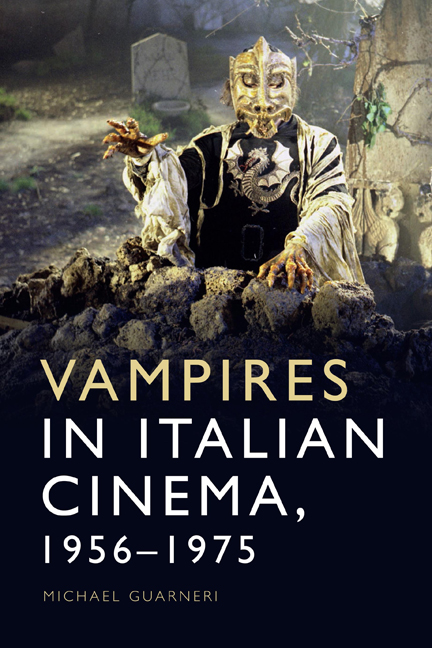Book contents
- Frontmatter
- Contents
- Figures and tables
- Acknowledgements
- Introduction
- PART I THE INDUSTRIAL CONTEXT
- PART II VAMPIRE SEX AND VAMPIRE GENDER
- PART III SANGUINE ECONOMY, BLOODY POLITIC
- Appendix A Three Italian vampire films that were never made
- Appendix B Files from the Italian Show Business Bureau fonds at the Archivio Centrale dello Stato in Rome
- Bibliography
- Index
1 - The Italian film industry (1945–1985)
Published online by Cambridge University Press: 10 October 2020
- Frontmatter
- Contents
- Figures and tables
- Acknowledgements
- Introduction
- PART I THE INDUSTRIAL CONTEXT
- PART II VAMPIRE SEX AND VAMPIRE GENDER
- PART III SANGUINE ECONOMY, BLOODY POLITIC
- Appendix A Three Italian vampire films that were never made
- Appendix B Files from the Italian Show Business Bureau fonds at the Archivio Centrale dello Stato in Rome
- Bibliography
- Index
Summary
SAFE BETS: THE ANDREOTTI SYSTEM AND MINIMO GARANTITO
If the overall aim of this monograph is to put filmic texts into context, thereby identifying the cultural instrumentality and national specificity of Italian vampire cinema, the first step is to sketch the industrial context in which the thirty-three vampire movies to be studied were made and consumed. In fact, as a cornerstone of the capital-intensive business of motion pictures, genre movies generally do not pop up out of the blue due to the sheer volition and idiosyncrasies of creative individuals, but are manufactured within, and shaped by, an institutional and economic framework in which national and international factors intertwine. In this sense, Riccardo Freda's account of the genesis of I vampiri can be quite instructive if subjected to close scrutiny. Speaking in the early 1970s, the Italian director (quoted in Cozzi 1971: 27–8) stated that he started making horror movies
because of a bet. I was talking with two producers one day, [Ermanno] Donati and [Luigi] Carpentieri. I said that a film could be made in two weeks, and they replied that it was impossible. I insisted, so they phoned [the owner of production and distribution company Titanus, Goffredo] Lombardo: they explained to Lombardo my proposal and asked if he wanted to distribute the film once it was finished. He accepted without much enthusiasm and I very quickly wrote a screenplay for I vampiri, which was shot in twelve days. Then I quit the job because I had an argument with the producers, and they completed the rest of the picture in two days. The movie was set in Paris but, thanks to the miniatures and tricks I created with cinematographer Mario Bava, we shot it in the courtyard of Titanus studio, in Rome.
In the early 1990s, Freda repeated the anecdote almost word by word, insisting on the low-budget nature of the project: ‘I agreed to shoot the movie in about ten days, demanding only Gianna Maria Canale as lead actress, Mario Bava as cinematographer and Beni Montresor as production designer’ (quoted in Della Casa 1993: 60). What Freda perfected through countless interviews is the typical retrospective tale about the golden age of post-war Italian cinema, in which skilled craftsmen do battle with the lack of money and time to break new ground (see just about any interview anthologised in Faldini and Fofi 1979 and 1981).
- Type
- Chapter
- Information
- Vampires in Italian Cinema, 1956-1975 , pp. 23 - 40Publisher: Edinburgh University PressPrint publication year: 2020



